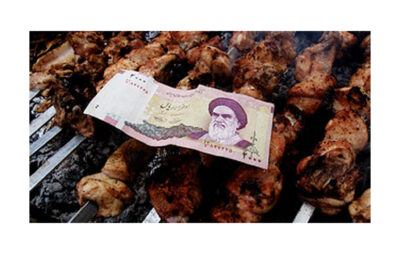Iran: Down, But Not Out
Since Mahmoud Ahmadinejad first became President of Iran, in August 2005, the country’s economy has gone from bad to worse. Iran now ranks near the bottom — 144 out of 183 countries — in the World Bank’s Doing Business 2012, an authoritative report that measures the vitality of free markets and the ease of doing business. The accompanying table indicates where Iran ranks relative to other countries in the Middle East and North Africa region.
For decades, the Iranian economy has been cobbled together by religious-bureaucratic regimes that have employed mandates, regulations, price controls, subsidies, a great deal of red tape, and a wide variety of other interventionist devices, in an attempt to achieve their goals. It’s all been kept afloat — barely afloat — by oil revenues.
Shortly after Ahmadinejad took power, Iran began to draw the ire of the United States and its allies over a number of issues related to its nuclear ambitions. And, more recently, Iran’s antagonism in the Strait of Hormuz, and support of Syrian President Bashar Al-Assad, have escalated these tensions. Of late, this loose coalition of “allies” has ratcheted up economic sanctions against Iran. The accompanying chronology of events sheds light on the sanctions.
Has the cascade of sanctions had an effect? The Iranian rial’s exchange rate tells the tale. When President Obama signed the Comprehensive Iran Sanctions, Accountability, and Divestment Act, in July 2010, the official Iranian rial-U.S. dollar exchange rate was very close to the black-market rate.
But, as the accompanying chart shows, the official and blackmarket rates have increasingly diverged since July 2010. With a dramatic fall in the value of the Iranian rial (IRR) on September 10, the black-market IRR/USD rate is now 52% lower than the official rate of 12,260 IRR/USD. When a currency collapses, you can be certain that other economic metrics are moving in a negative direction, too. For example, using the IRR/USD black-market exchange rate, as of September 10, I estimate that Iran is experiencing an annual inflation rate of 71%.
To obtain a clear picture of the economic conditions experienced by the majority of Iranians, we can construct a misery index. The index is the sum of the inflation, interest and unemployment rates, minus the annual percentage change in per capita GDP.
Iran’s misery index, for the 1991-2012 period, is presented in the accompanying chart. It must be stressed that Iran’s true inflation, interest and unemployment rates are probably higher than those reported. In consequence, the true level of the index is probably higher than the one displayed in the accompanying chart. That said, the pattern of “ups” and “downs” in the index is reliable.
Several things stand out: the level of the index has been quite elevated during the 1991-2012 period. The Rafsanjani years were a bit of a roller coaster ride, with a dramatic increase, followed by a sharp reduction, and then a final up-tick in the level of “misery.” The Khatami years were characterized by relative stability and a mild improvement in the state of economic affairs. The Ahmadinejad period has been marked by a steady deterioration in economic conditions — punctuated by a dramatic economic decline since late 2011.
A comparable misery index for Egypt is shown to illustrate just how bad the state of Iran’s economy has been over the years. Since 1993, Egypt’s misery index has never exceeded 40, even during the height of the Arab Spring.
Whereas, the Iranian misery index has often been above 40 and has recently shot up to 106.
There is no question that the sanctions the “allies” are imposing on Iran are starting to bite, and bite pretty hard. But, will this coercion win the “war?” Probably not. Prof. John Mearsheimer, in his masterpiece, The Tragedy of Great Power Politics, provides more than ample evidence to show that naval blockades and strategic bombing (and I would add financial sanctions) rarely produce their desired results. As Prof. Mearsheimer concludes:
“…the populations of modern states can absorb great amounts of pain without rising up against their governments. There is not a single case in the historical record in which either a blockade or a strategic bombing campaign designed to punish an enemy’s population caused significant public protests against the target government. If anything, it appears that ‘punishment generates more public anger against the attacker than against the target government.’”
Even though the sanctions are causing untold misery in Iran, history suggests that a good dose of skepticism about whether the Iranians will comply with the demands of the “allies” is in order — as Prof. Mearsheimer writes:
“…governing elites are rarely moved to quit a war because their populations are being brutalized. In fact, one could argue that the more punishment that a populations suffers, the more difficult it is for the leaders to quit the war. The basis of this claim, which seems counterintuitive, is that bloody defeat greatly increases the likelihood that after the war is over the people will seek revenge against the leaders who led them down the road to destruction. Thus, those leaders have a powerful incentive to ignore the pain being inflicted on their population and fight to the finish in the hope that they can pull out a victory and save their own skin.”
So, in one sense, the sanctions are working; they are imposing a great deal of misery on Iranians. But, in another sense, they will probably fail — fail to force the mullahs to comply. Perhaps that’s why Russia’s wily foreign minister, Sergey V. Lavrov confidently stated that “Russia is fundamentally against [adopting even more sanctions], since for resolving problems, you have to engage the countries you are having issues with, and not isolate them.”
References:
David Herszenhorn and Steven L. Meyers. “For Putin, a Flight of Fancy at a Summit Meeting’s Close.” The New York Times, 10 Sept. 2012.
Gary C. Hufbauer, Jeffrey J. Schott, Kimberly A. Elliott, Julia Muir, and Milica Cosic. “Case 2006-1 UN, US [EU] v. Iran (2006—: Proliferation).” Case Studies in Economic Sanctions and Terrorism. Peterson Institute for International Economics, June 2012.
Toni Johnson and Greg Bruno. “The Lengthening List of Iran Sanctions.” Council on Foreign Relations., 31 July 2012.
John J. Mearsheimer. The Tragedy of Great Power Politics. New York, NY: W.W. Norton, 2003.
This article appeared in the October 2012 issue of Globe Asia.












